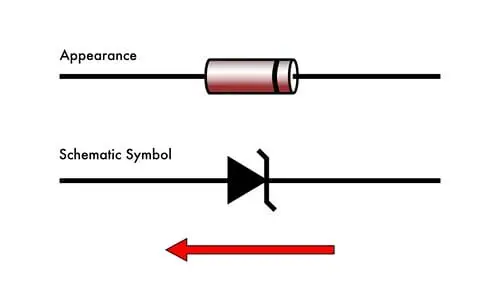In the modern world, without the applications of semiconductor diodes, most of our electronic devices will stop functioning. In other words, all electronic devices will become useless. Out of all the different types of semiconductor diodes, a Zener diode is the most commonly used.
A Zener diode is one of the special kind of reverse bias diode. In this article, I will give you a brief Zener diode introduction in a very simplistic approach. So, sit tight, and enjoy the ride. Here are some points you should be asking about the Zener diode.
- Zener diode definition
- Construction of Zener diode
- Working of Zener diode
- Avalanche diode vs Zener diode
- Zener diode characteristics curve
- Advantages of Zener diode
- Disadvantages of Zener diode
- Applications of Zener diode
Zener Diode Definition
What does a Zener diode do? Well, a Zener diode is basically a type of semiconductor diode in which current can flow forward as well as in the reverse direction. This diode is fundamentally a silicon-based, heavily doped p-n junction diode.
In 1934, the theoretical foundation of Zener diode was given by an American physicist named Clarence Zener. That’s why this type of semiconductor diode is known as Zener diode.
Must read, Alternating Current (AC) vs Direct Current (DC) in Tabular Form
Construction Of Zener Diode

Just like a laser diode, the Zener diode is also a modified form of the heavily doped silicon-based p-n junction diode. In the case of Zener diodes, the depletion region (see figure) is intensely made very thin.
Therefore, as a result, even for a small reverse voltage, electrons can easily tunnel from the valence band of the p-type material to the conduction band of the n-type material. After going through the construction of a Zener diode, the next question you should be asking is how does a Zener diode work?
Check out, A Brief History Of Compton Effect
Working Of Zener Diode
Well, how a Zener diode works? As I said in the section about the Zener diode definition, the current can flow in forward as well as in reverse direction.
Without Biasing
When there is no bias applied to the Zener diode, there will be no movement of electrons. Hence no current will flow through the diode. Meaning, the electrons from the valance band of p-type material will not move to the conduction band of n-type material. Hence, no current will flow through the Zener diode.
With Biasing

When forward biasing is applied, a Zener diode in forward bias will certainly behave as a normal diode. On the other hand, when reverse biasing is applied, a Zener diode in reverse bias will behave contradictory as compared to the normal diodes.
Meaning, when reverse biasing is applied, the intensity of the electric field increases across the diode. Hence, electrons can freely move from the valence band of the p-type material to the conduction band of the n-type material.
Due to the increased movement of electrons, the depletion region (which is already quite thin because of high impurity doping) starts to decrease rapidly. Finally, at some certain voltage, the depletion region vanishes completely.
Therefore, as a result, the diode starts conducting in the reverse-biased mode. That’s why a Zener diode is also known as a breakdown diode.

The voltage at which the depletion region vanishes completely is known as Zener diode breakdown voltage or simply Zener voltage. On the other hand, the principle behind the working of Zener diode is known as Zener breakdown or simply Zener effect.
There is one more type of breakdown effect similar to Zener breakdown i.e Avalanche breakdown. Just to make sure that you don’t get confused between Zener breakdown and avalanche breakdown. Let’s discuss some of its differences.
Avalanche Diode vs Zener Diode
Well, avalanche breakdown and Zener breakdown is an almost similar effect. Because they both exclusively works on reverse-biased voltage. Apart from that, there are also some differences between them that you should know.
- Avalanche diodes are dominant above 5.6 volts. On the other hand, if I talk about Zener diode, they are dominating in voltage range up to 4.6 volts.
- Zener diodes have a negative temperature coefficient. Whereas, avalanche diodes have a positive temperature coefficient.
- Avalanche diodes are lightly doped. On the other hand, Zener diodes are heavily doped.
- Zener breakdown occurs at lower reverse voltage. Whereas, avalanche breakdown normally occurs at high reverse voltage.
- Avalanche diode comes in the category of passive diodes. On the other hand, if I talk about Zener diodes, they come in the category of active diodes.
Zener Diode Characteristics Curve
Characteristics of Zener diode is nothing but a graphical representation showing how a Zener diode works when a forward or reverse voltage is applied. In order to give you a clear picture, here, I have graphically represented both the avalanche and Zener diode characteristics curve. For simplicity, let me divide the graph into two parts.
Editors’ Choice: What are Conductors? – Definition, Types, Facts & Examples

Forward Characteristics
The first quadrant of the above graph represents the forward characteristics of the Zener diode. The forward characteristic of the Zener diode (and avalanche diode) is almost similar to the ordinary semiconductor diodes.
Reverse Characteristics
The third quadrant of the above graph represents the reverse characteristics of the Zener diode. You can see from the graph that when the reverse voltage is applied beyond the certain voltage (Zener voltage), there is an exponential increase in the reverse current. Hence, a Zener breakdown occurred.
must read, An Introduction To Modern Physics
It is also evident from the above graph that the reverse voltage required for avalanche breakdown is high as compared to the Zener diode breakdown voltage.
Advantages Of Zener Diode
- Zener diodes are cheap as compared to other diodes.
- They are reliable.
- Zener diodes are compatible with most of the system
- They consume less power etc.
Disadvantages of Zener diode
- They have a poor regulation ratio.
- Zener diodes cancel out voltages by applying even larger voltages in the reverse direction, wasting electricity in the process, etc.
Applications Of Zener Diode
In the modern world, there is a wide range of Zener diode uses mostly in commercial and industrial applications. Well, in this article, I can’t enlist them all. But some of the main Zener diode applications are as follow:
- Zener diode as voltage regulator
- As a voltage shifter
- Zener diode as waveform clipper
- For meter protection etc.
Editor’s Choice: What are Insulators? – Definition, Types & Examples
That’s it for this post. If there are any suggestions, or I have missed something, feel free to comment. If you like this article, share it if you like, like it if you share it. You can also find us on Mix, Twitter, Pinterest, and Facebook.
